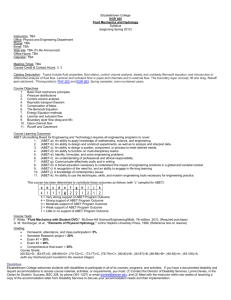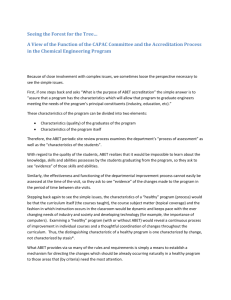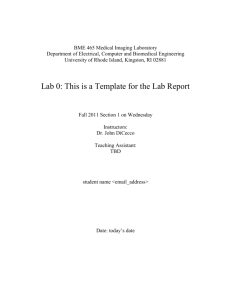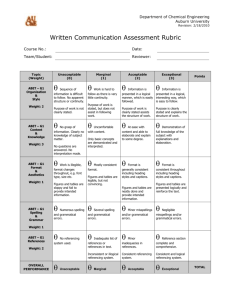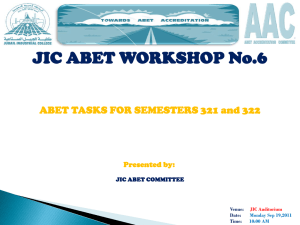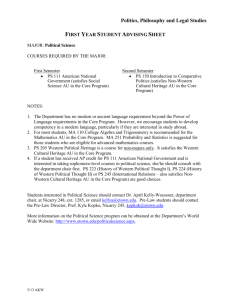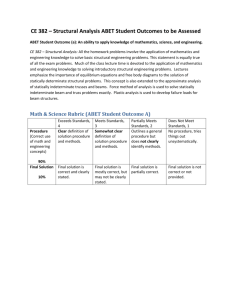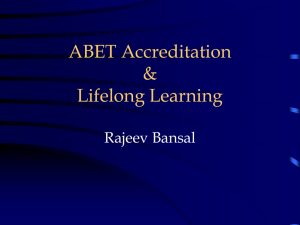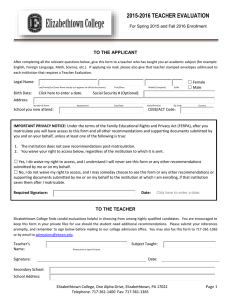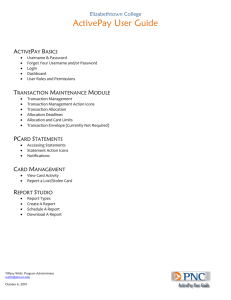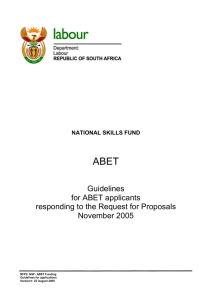EGR 343 - My E-town -- Personal Home Pages
advertisement
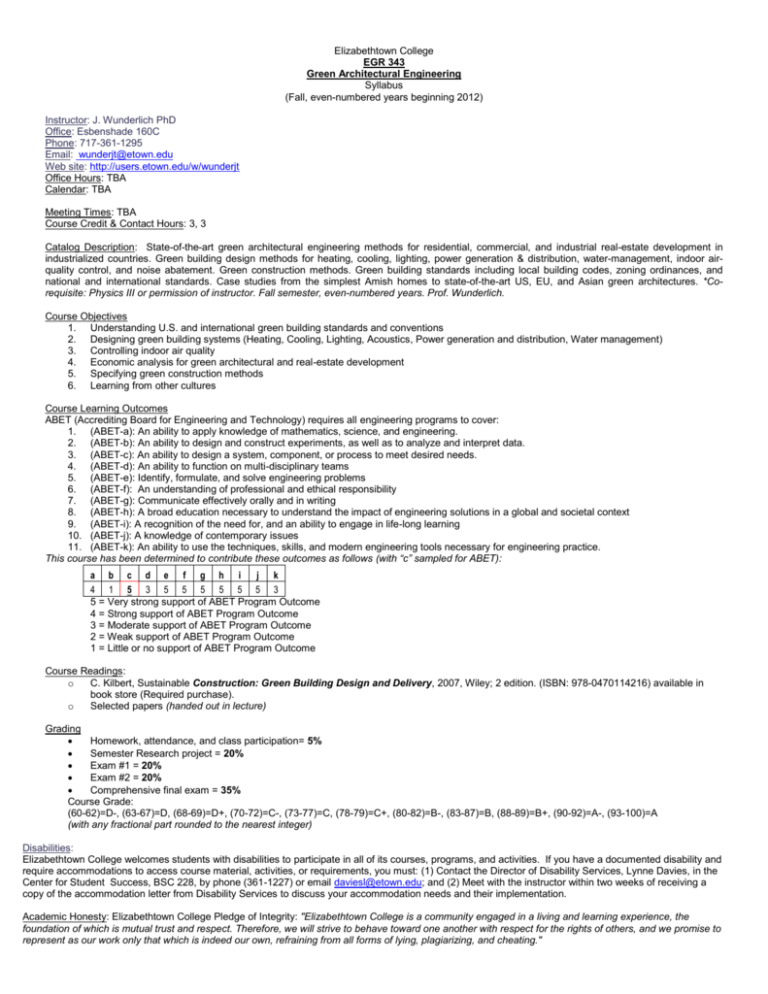
Elizabethtown College EGR 343 Green Architectural Engineering Syllabus (Fall, even-numbered years beginning 2012) Instructor: J. Wunderlich PhD Office: Esbenshade 160C Phone: 717-361-1295 Email: wunderjt@etown.edu Web site: http://users.etown.edu/w/wunderjt Office Hours: TBA Calendar: TBA Meeting Times: TBA Course Credit & Contact Hours: 3, 3 Catalog Description: State-of-the-art green architectural engineering methods for residential, commercial, and industrial real-estate development in industrialized countries. Green building design methods for heating, cooling, lighting, power generation & distribution, water-management, indoor airquality control, and noise abatement. Green construction methods. Green building standards including local building codes, zoning ordinances, and national and international standards. Case studies from the simplest Amish homes to state-of-the-art US, EU, and Asian green architectures. *Corequisite: Physics III or permission of instructor. Fall semester, even-numbered years. Prof. Wunderlich. Course Objectives 1. Understanding U.S. and international green building standards and conventions 2. Designing green building systems (Heating, Cooling, Lighting, Acoustics, Power generation and distribution, Water management) 3. Controlling indoor air quality 4. Economic analysis for green architectural and real-estate development 5. Specifying green construction methods 6. Learning from other cultures Course Learning Outcomes ABET (Accrediting Board for Engineering and Technology) requires all engineering programs to cover: 1. (ABET-a): An ability to apply knowledge of mathematics, science, and engineering. 2. (ABET-b): An ability to design and construct experiments, as well as to analyze and interpret data. 3. (ABET-c): An ability to design a system, component, or process to meet desired needs. 4. (ABET-d): An ability to function on multi-disciplinary teams 5. (ABET-e): Identify, formulate, and solve engineering problems 6. (ABET-f): An understanding of professional and ethical responsibility 7. (ABET-g): Communicate effectively orally and in writing 8. (ABET-h): A broad education necessary to understand the impact of engineering solutions in a global and societal context 9. (ABET-i): A recognition of the need for, and an ability to engage in life-long learning 10. (ABET-j): A knowledge of contemporary issues 11. (ABET-k): An ability to use the techniques, skills, and modern engineering tools necessary for engineering practice. This course has been determined to contribute these outcomes as follows (with “c” sampled for ABET): a b c d e f g h i j k 4 1 5 3 5 5 5 5 5 5 3 5 = Very strong support of ABET Program Outcome 4 = Strong support of ABET Program Outcome 3 = Moderate support of ABET Program Outcome 2 = Weak support of ABET Program Outcome 1 = Little or no support of ABET Program Outcome Course Readings: o C. Kilbert, Sustainable Construction: Green Building Design and Delivery, 2007, Wiley; 2 edition. (ISBN: 978-0470114216) available in book store (Required purchase). o Selected papers (handed out in lecture) Grading Homework, attendance, and class participation= 5% Semester Research project = 20% Exam #1 = 20% Exam #2 = 20% Comprehensive final exam = 35% Course Grade: (60-62)=D-, (63-67)=D, (68-69)=D+, (70-72)=C-, (73-77)=C, (78-79)=C+, (80-82)=B-, (83-87)=B, (88-89)=B+, (90-92)=A-, (93-100)=A (with any fractional part rounded to the nearest integer) Disabilities: Elizabethtown College welcomes students with disabilities to participate in all of its courses, programs, and activities. If you have a documented disability and require accommodations to access course material, activities, or requirements, you must: (1) Contact the Director of Disability Services, Lynne Davies, in the Center for Student Success, BSC 228, by phone (361-1227) or email daviesl@etown.edu; and (2) Meet with the instructor within two weeks of receiving a copy of the accommodation letter from Disability Services to discuss your accommodation needs and their implementation. Academic Honesty: Elizabethtown College Pledge of Integrity: "Elizabethtown College is a community engaged in a living and learning experience, the foundation of which is mutual trust and respect. Therefore, we will strive to behave toward one another with respect for the rights of others, and we promise to represent as our work only that which is indeed our own, refraining from all forms of lying, plagiarizing, and cheating." Course Outline I. Green building fundamentals a. History b. Green building assessment c. Building standards i. International standards and conventions ii. L.E.E.D (Leadership in Energy and Environmental Design) iii. Local U.S. building codes iv. Local U.S. zoning ordinances II. Green building systems a. Sustainable sites and landscaping b. Green heating and cooling system design c. Green water usage, collection, and distribution d. Green power generation i. Active and passive solar design ii. Wind iii. Biomass e. Green power distribution and usage f. Green Illumination design g. Specifying green materials h. Controlling indoor environmental quality i. Contaminants (mold, asbestos, out-gassing) i. Acoustics and noise abatement III. Green building implementation a. Construction staging and scheduling b. Economic analysis of green buildings i. Tax incentives c. Minimizing construction waste d. Minimizing construction time and energy IV. Case studies a. Amish homes b. State-of-the-art US, EU, and Asian green architectures Changes: This syllabus provides a guideline to the expectations for the course; minor changes may be made during the semester Semester Project No project previously built for another course will be accepted. Groups of two preferred, but individual or groups of three may be approved. PROPOSAL: Due date to be announced. Late penalties apply. Use PowerPoint. It should take approximately 5 minutes. At the very least do a “GOOGLE SCHOLAR” search for your topic and discuss what you will be researching. PRESENTATION: Due date to be announced. Late penalties apply. Use PowerPoint. It should take 10 minutes; Penalty applied if 15 minutes exceeded. Tips on presentations: Minimize unnecessary details Less than 30 words per slide Don’t have too many slides Ensure good contrast between text and background (will the lights be on?) A picture is worth a thousand words -- an equation or graph can be worth much more Put an image on every page (clip-art, photo, animation) which is an abstraction of the subject Don’t read from script Don’t speak monotonically Don’t have too many (or annoying) sound effects Make eye contact with audience Have a clear objective (to entertain, to sell, to motivate, or to report findings) Have a good opener (an agenda, a quotation, a question, or a declaration) Be organized and logical (present problem then solution; or have priorities – least-to-most or most-to-least) Have audience’s expectations understood (provide meaning and/or motivation) Have good transitions between main points Have a good closing (summarize main ideas, restate purpose of presentation) Be flexible (adapt if questions are asked during presentation) PAPER: Late penalties apply. Must be in two-column, single-spaced, 10-point font using IEEE formatting dictated by: http://users.etown.edu/w/wunderjt/IEEE_CONF_PAPER_FORMATTING.pdf. Paper should be 4 to 6 pages (2 to 3 if you decide to build something and it works – not required or recommended for this course). Include: An Abstract (one or two paragraphs) An Introduction section A number of discussion sections A Conclusions section A bibliography (a list of citations) – call it “References.” Excessive use of Wikipedia and non-scholarly citations will be penalized. See: http://www2.etown.edu/library/scholarlyjournals.htm (USE LIBRARY and GOOGLE SCHOLAR !! ) Appendices for supporting materials (simulation code, sketches, data collected, manufacturers literature, etc.) On final presentation day, submit before you present: 1. A printed stapled copy of your PowerPoint presentation; six slides per page 2. A printed stapled copy of your paper 3. All engineering majors put a copy of your group’s paper and presentation in your individual folder in the “Engineering Portfolios” folder on the “J:” network drive. 4. Email your paper and presentation to me
